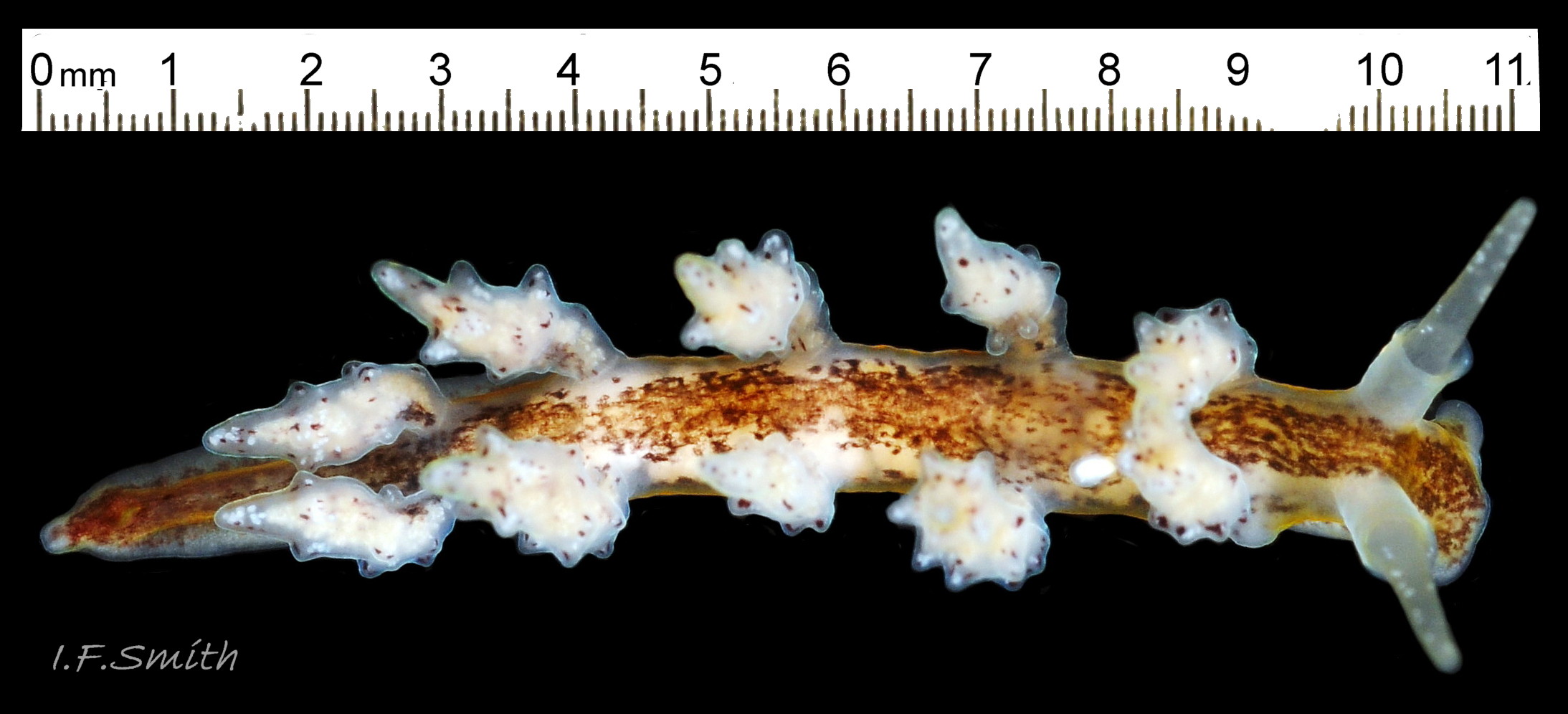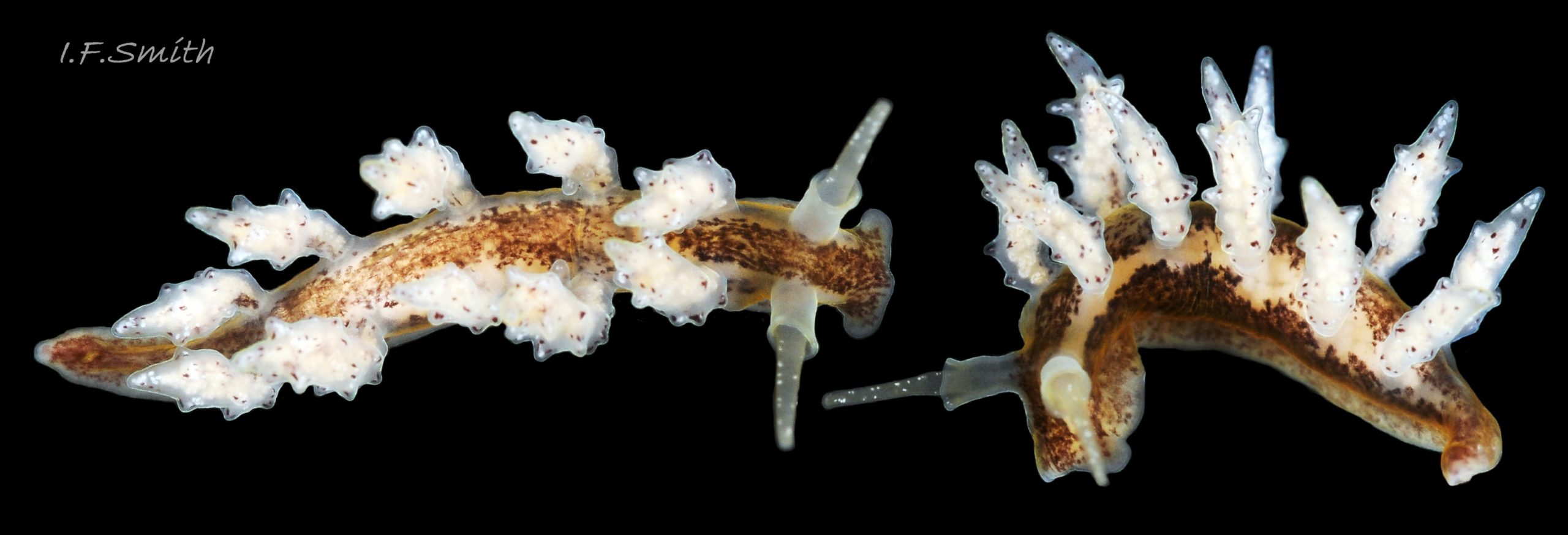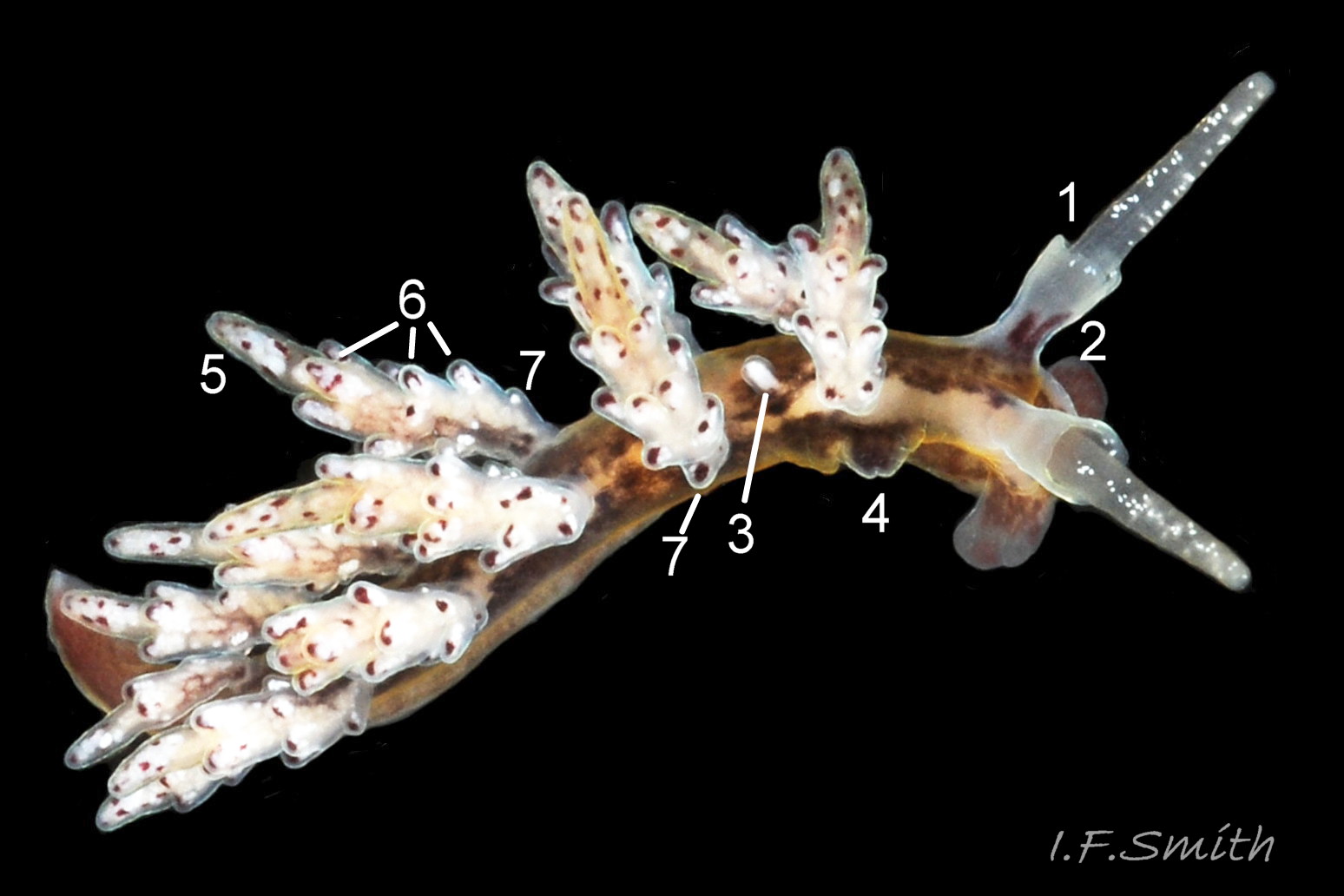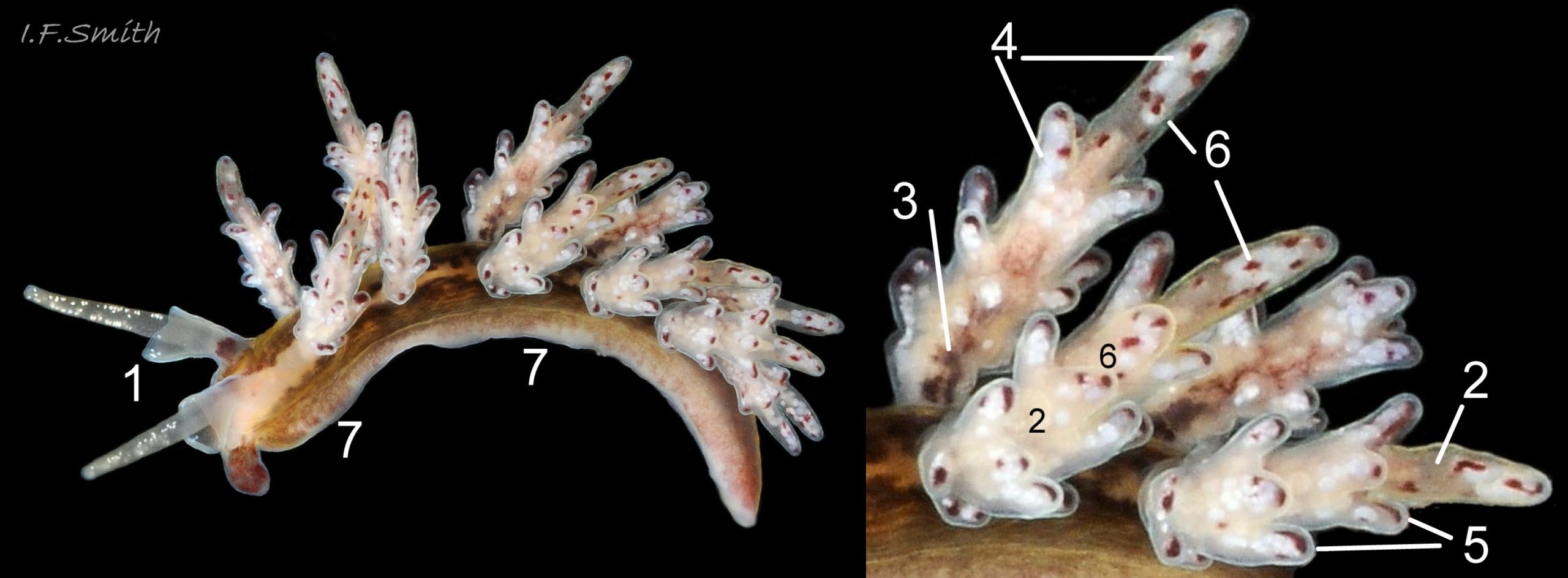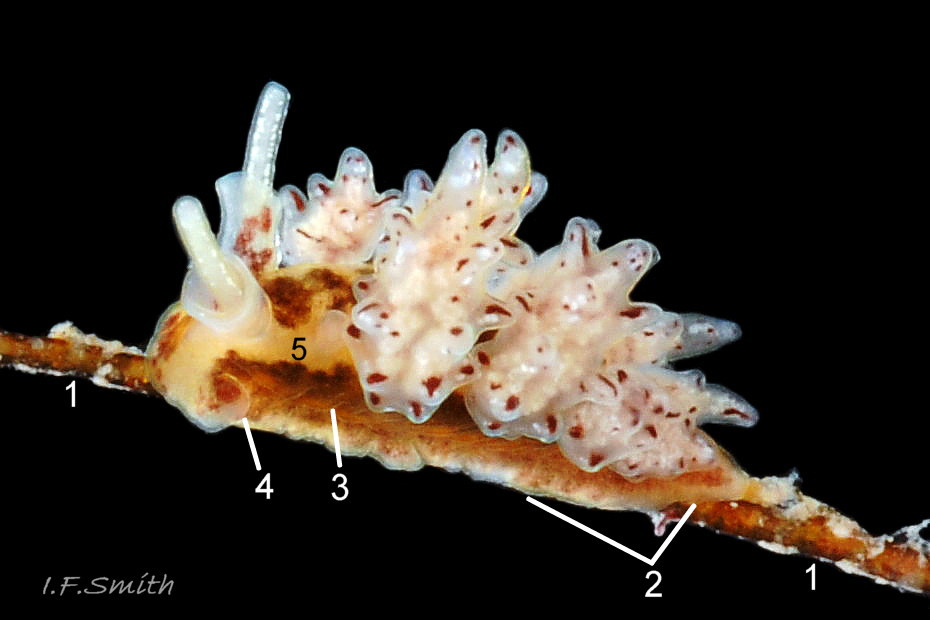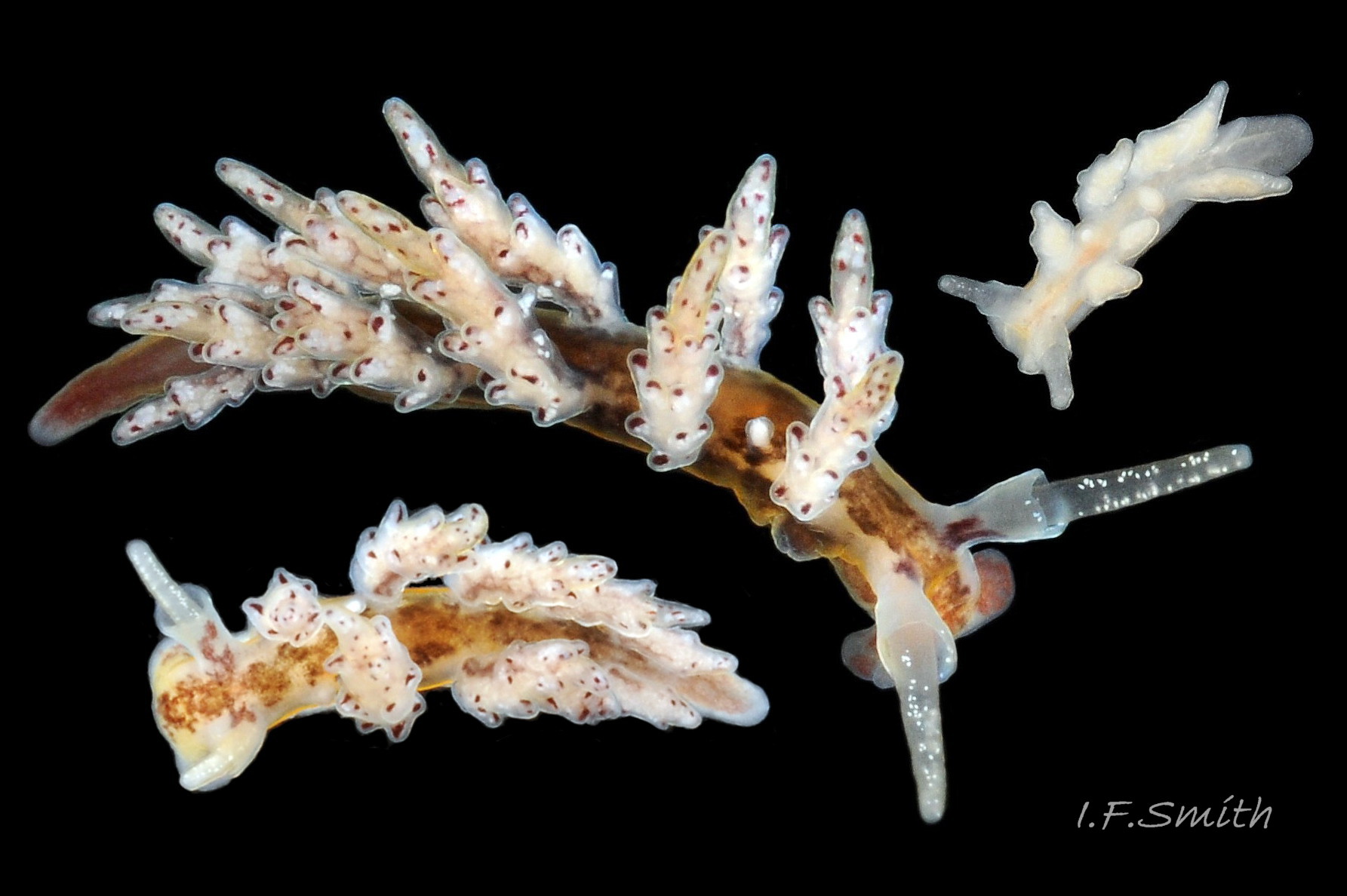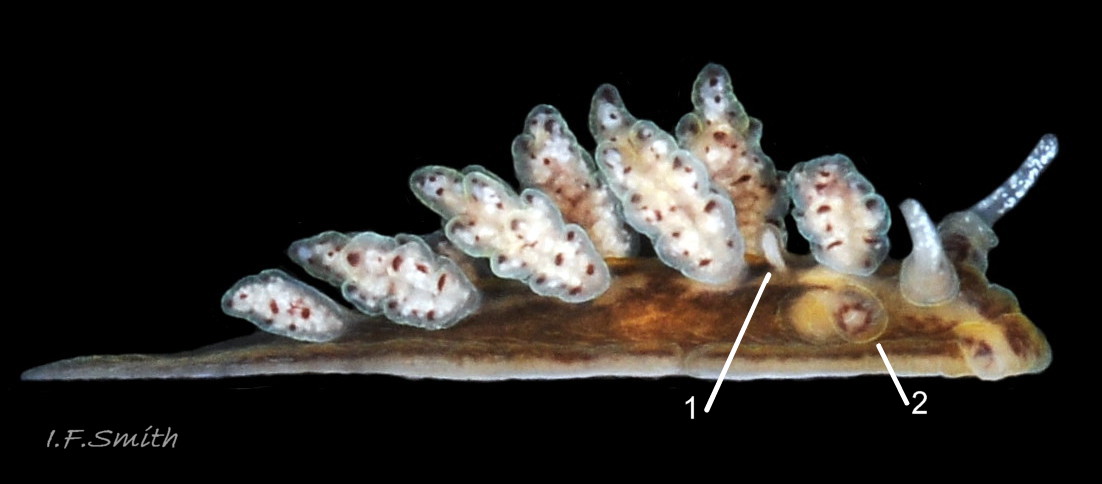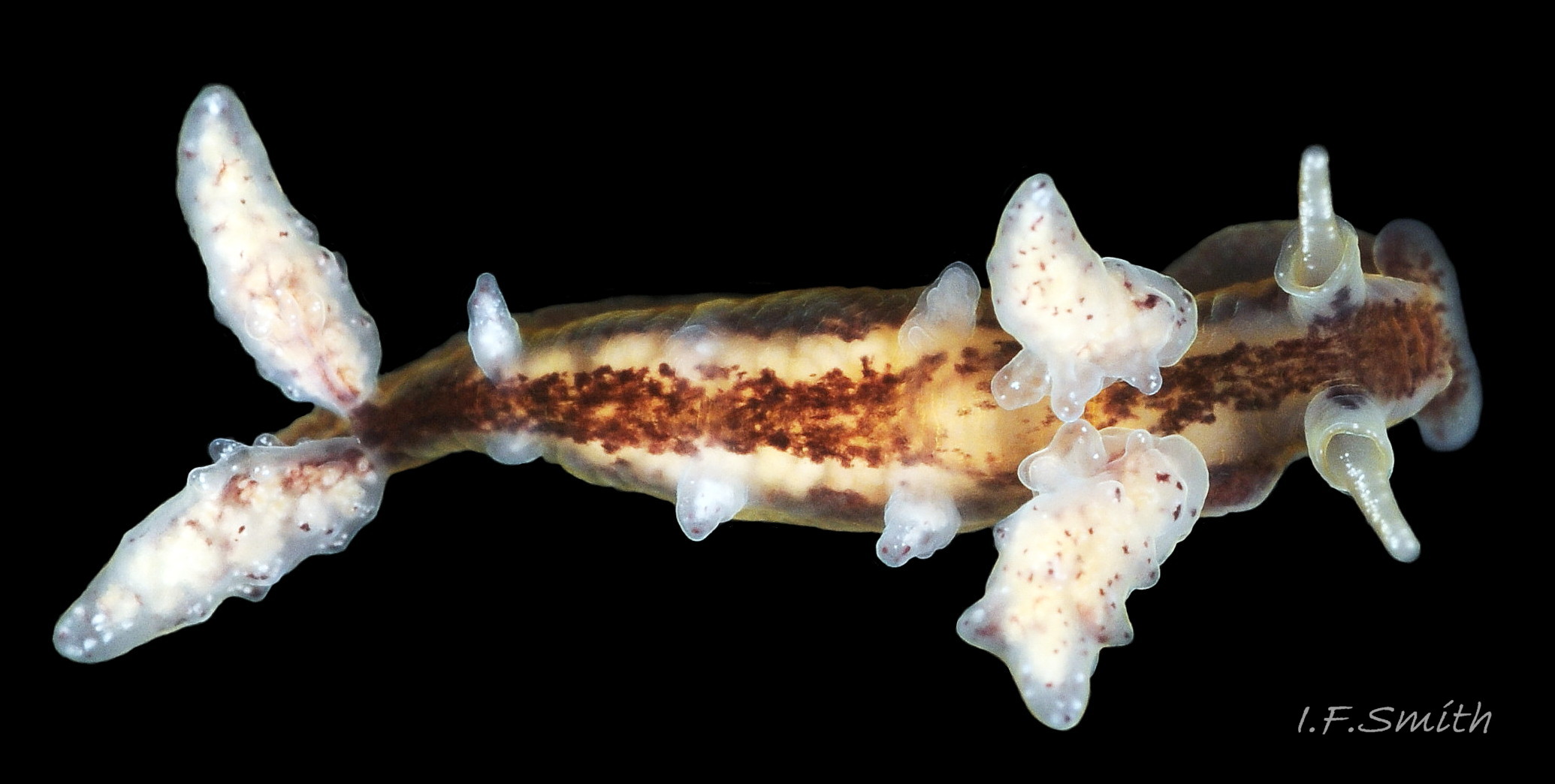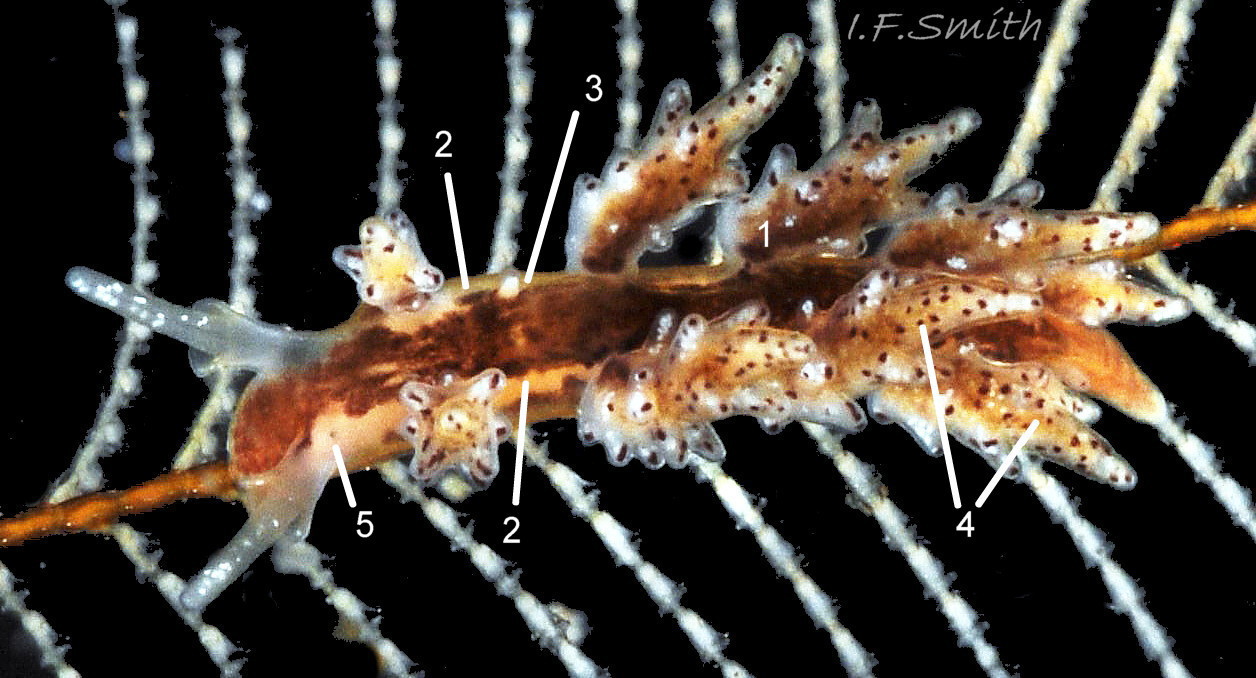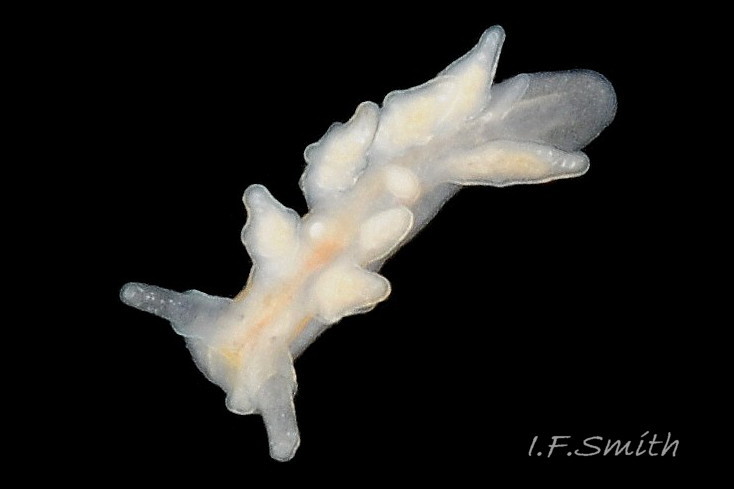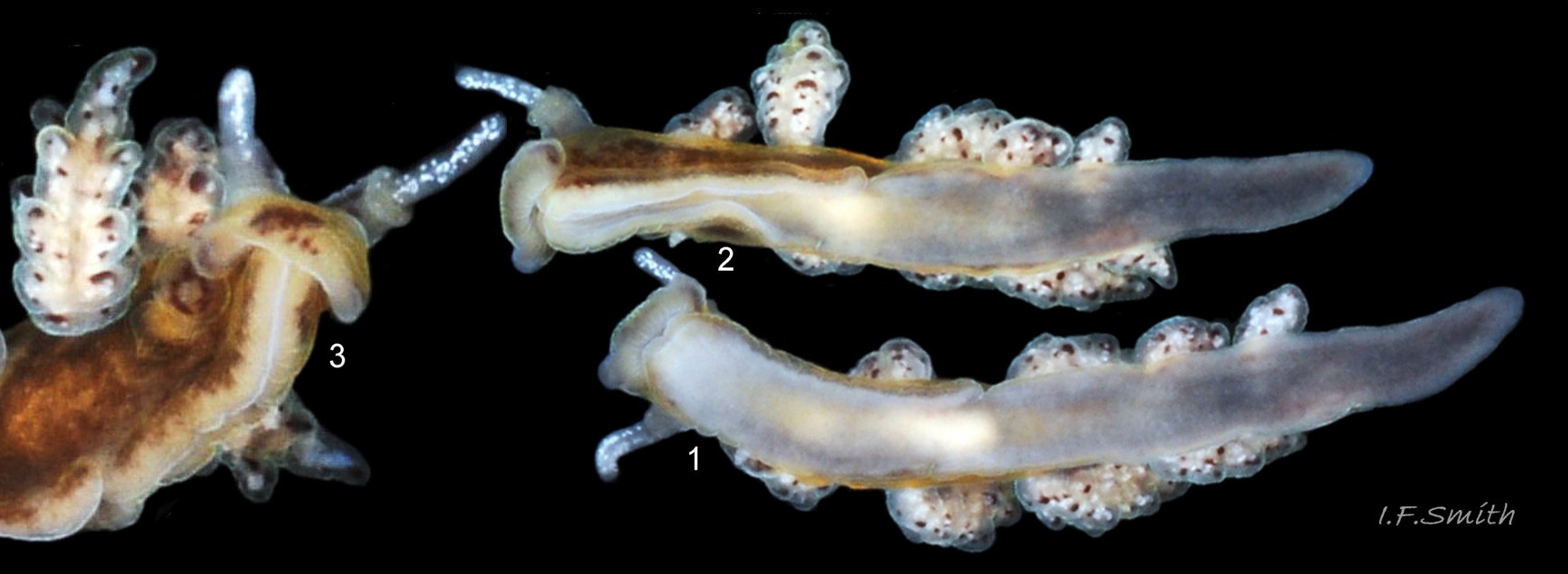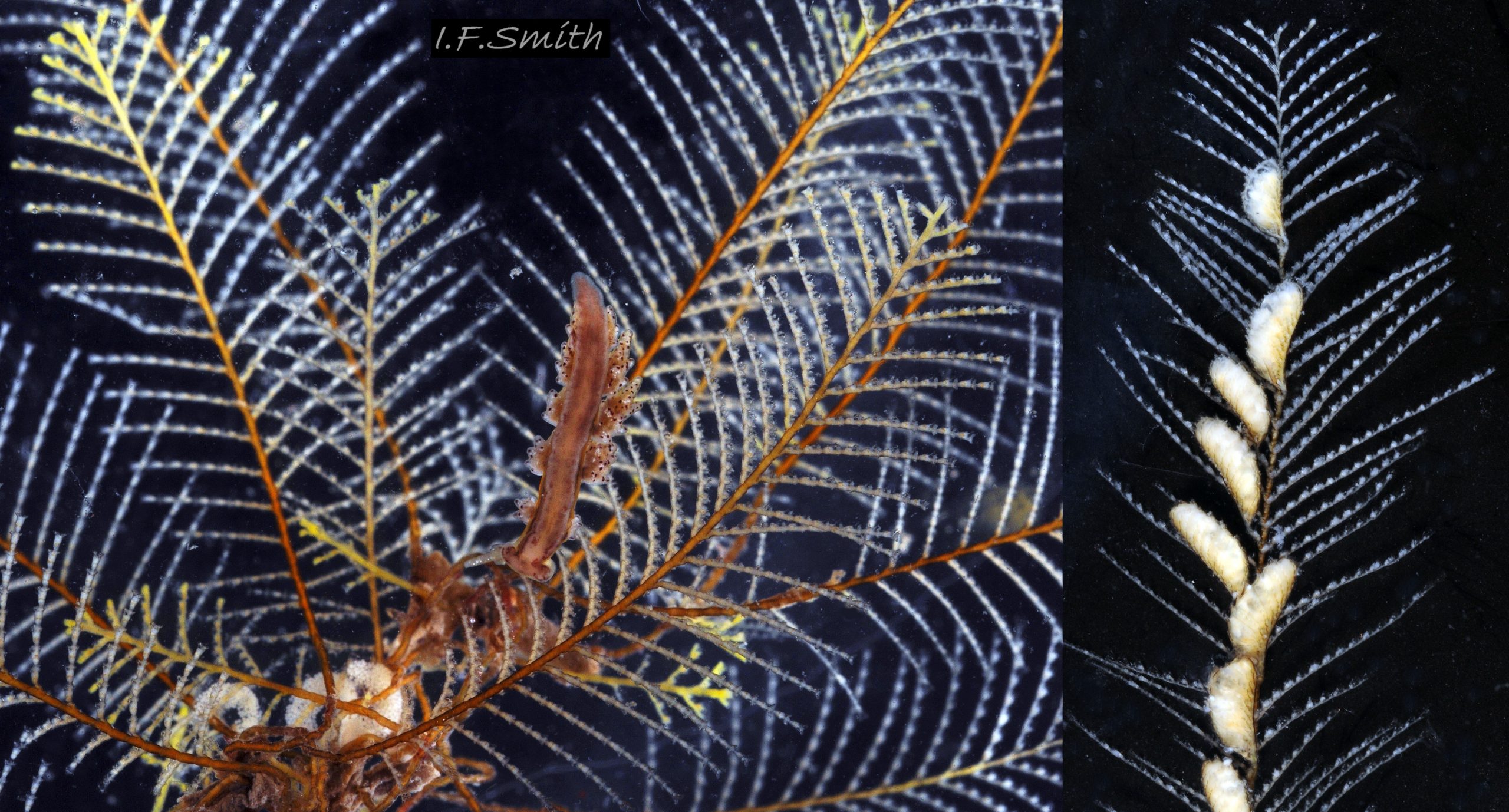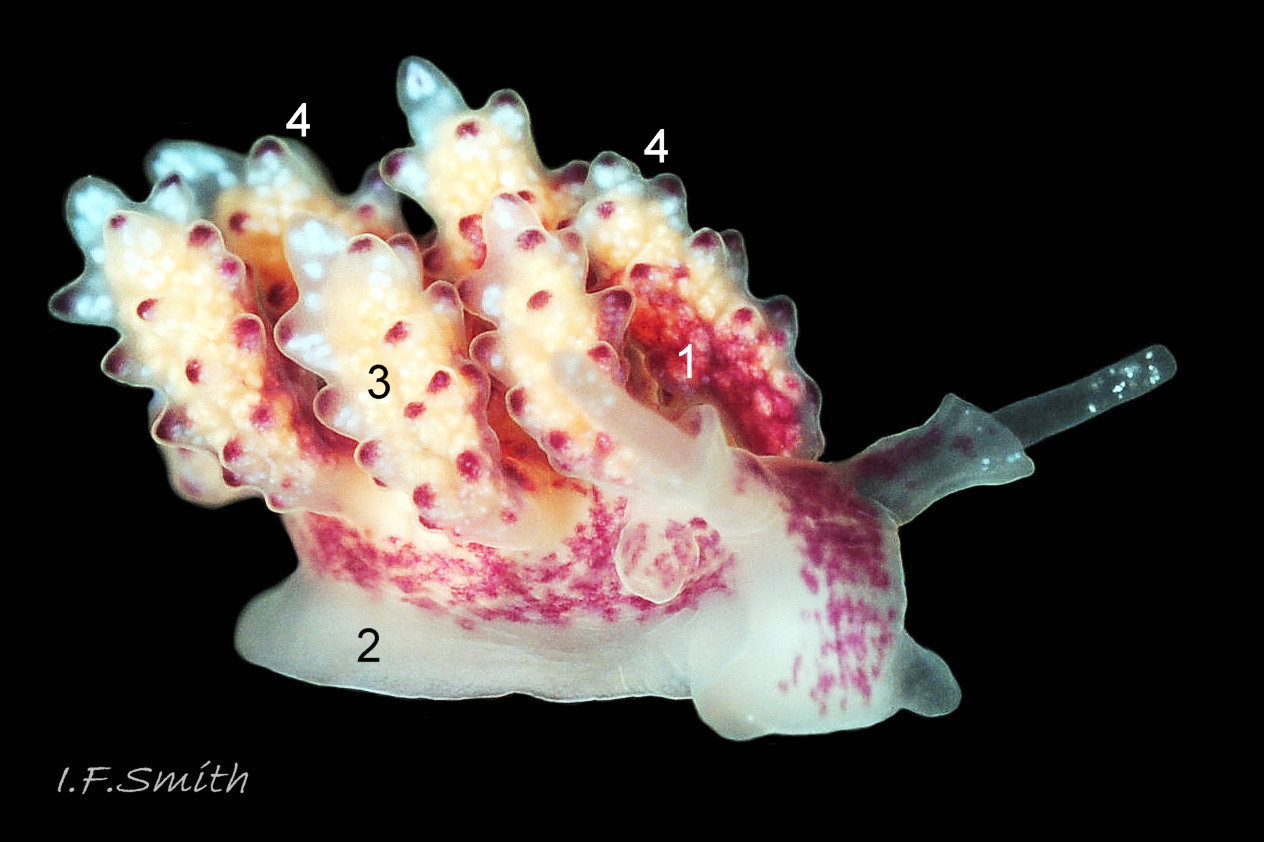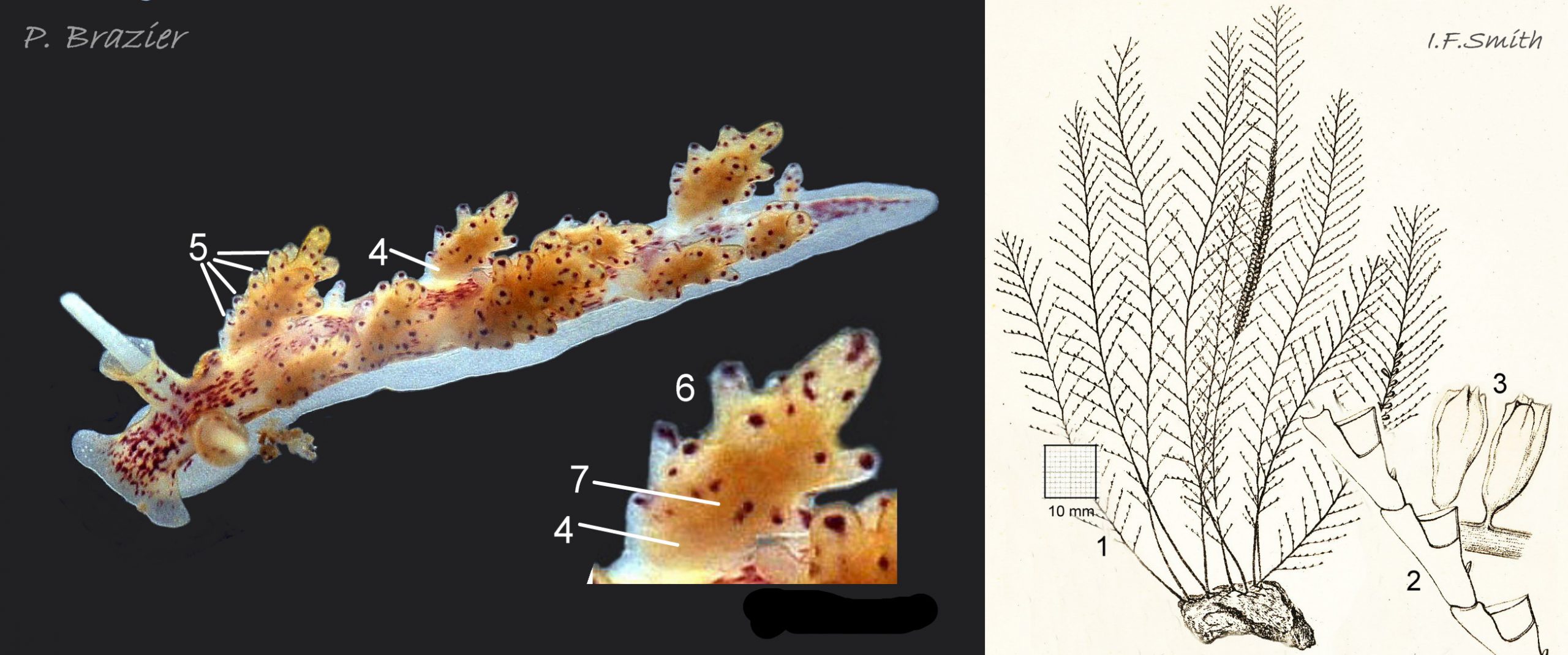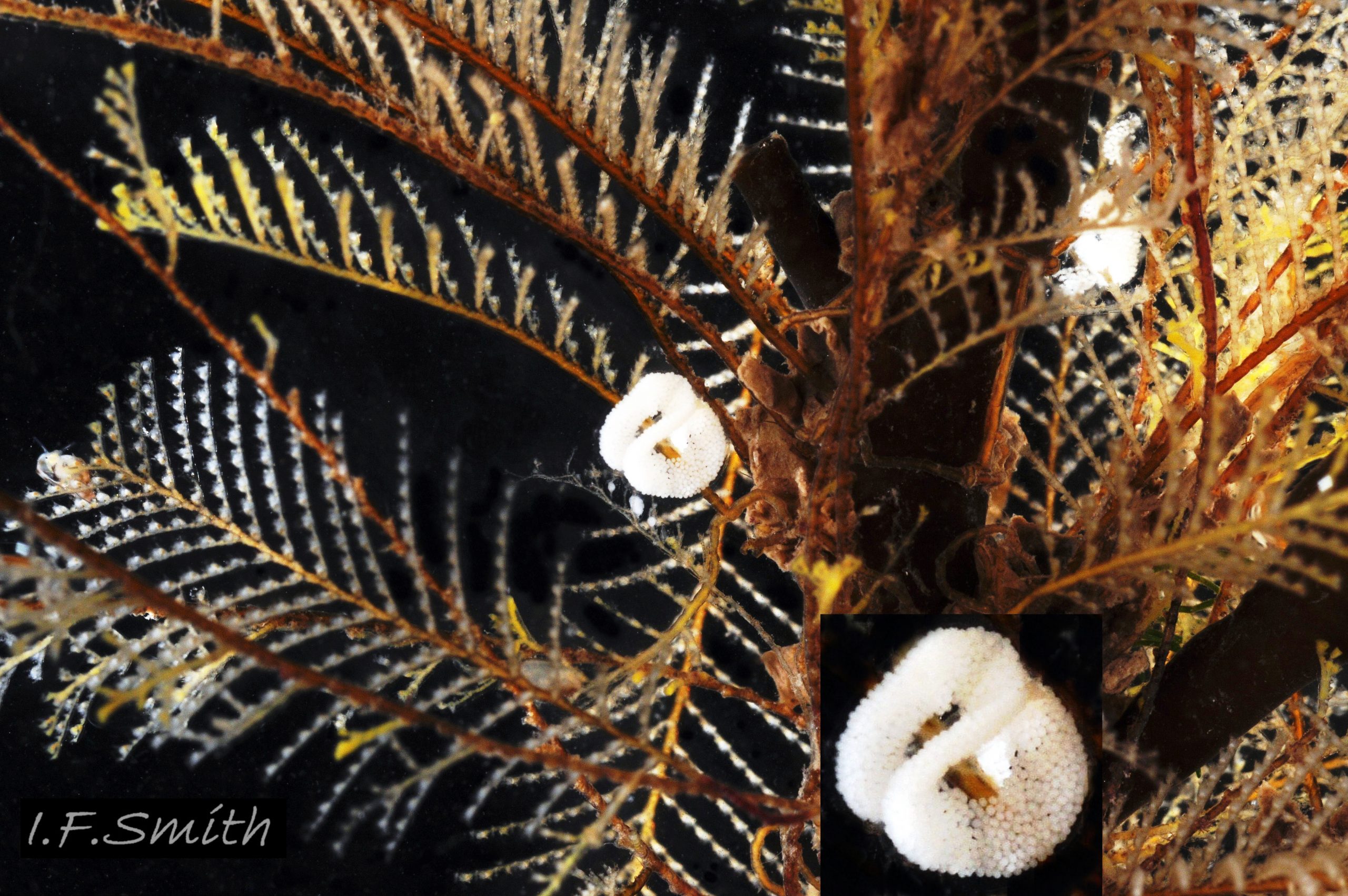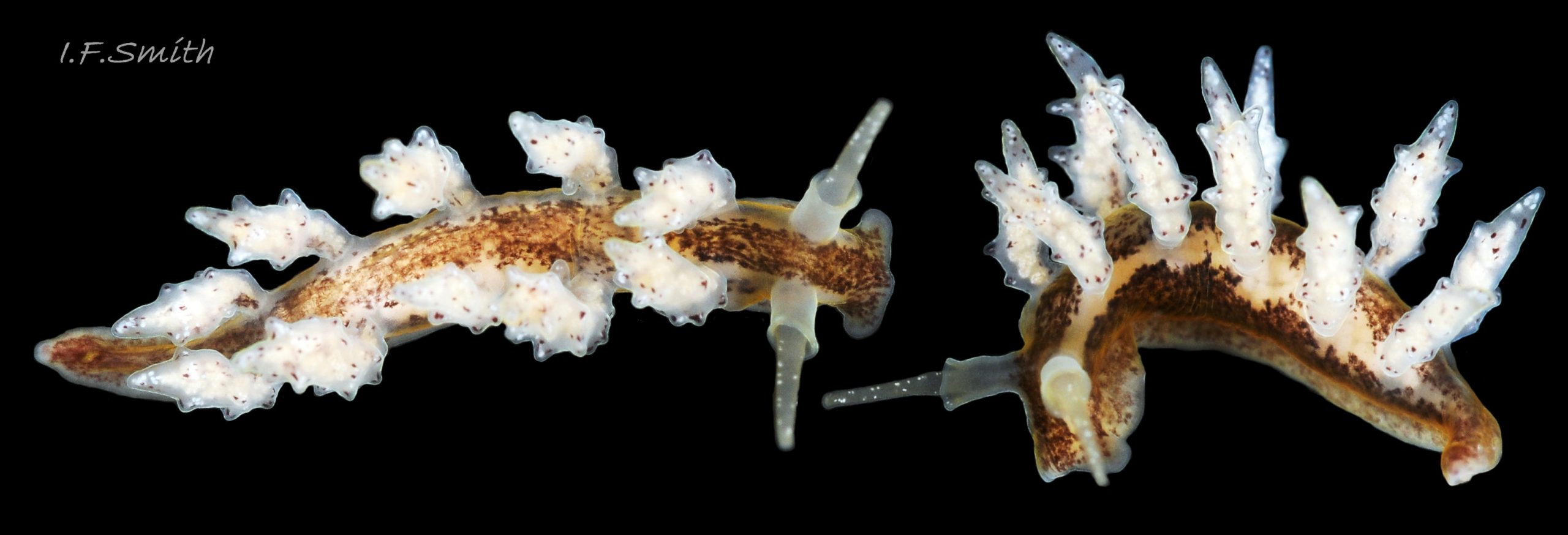Click image to enlarge with full caption. Main text below slider.
Doto koenneckeri Lemche, 1976
Current taxonomy; World Register of Marine Species
www.marinespecies.org/aphia.php?p=taxdetails&id=139631
Synonyms
D. koenneckeri was segregated from D. coronata sensu lato in 1976.
GLOSSARY BELOW
Body description
The adult body is usually up to about 11 mm long ( 01 Doto koenneckeri. ), maximum about 14 mm (Trigo et al., 2018) . On adults, most of the translucent whitish epidermis is covered by dark brown surface pigment, and the unpigmented parts are tinted yellowish by the viscera. There is a conspicuous, pale, unpigmented dorsolateral band on either side linking the bases of the rhinophore sheath and cerata ( 02 Doto koenneckeri. ). The rhinophores ( 03 Doto koenneckeri. & 04 Doto koenneckeri. ) and their basal sheaths are translucent whitish, with many opaque white granules on the rhinophores and a few near the rim of the sheaths, which sometimes have some brown pigment on the mesial face. The sheath rims can dilate and contract. Brown pigment extends onto the dorsal surface of the foot and onto the lateral flaps of the oral veil ( 05 Doto koenneckeri. ). Juveniles up to 2 mm long are usually white with, dorsally, a faint brownish tint which increases in saturation and extent with growth ( 06 Doto koenneckeri. & 11 Doto koenneckeri. ).
On the animal’s right, there is an elongated, white, anal papilla between the first and second ceras ( 07 Doto koenneckeri. ), and below the first ceras there is a large, hermaphrodite, genital papilla which can be brown or pigmentless ( 03 Doto koenneckeri. & 07 Doto koenneckeri. ).
The head has an oral veil which can be varied in shape and extent, but it usually has an approximately oblong outline with lateral flaps which, when fully expanded, are strongly rounded ( 08 Doto koenneckeri. ). There are no head crests or distinct pseudobranchs. The brown pigment of the body and head extends onto the dorsal surface of the oral veil except for the continuation onto it of the unpigmented dorsolateral bands ( 08 Doto koenneckeri. ). A small, black, internal eye is sometimes indistinctly visible at the rear of the rhinophoral sheath ( 10 Doto koenneckeri. & 11 Doto koenneckeri. ).
There is a dorsolateral row of solitary cerata on each side of the body. The number of cerata in each row increases with growth to a usual maximum of six ( 06 Doto koenneckeri. ); the most recent addition, at the posterior, is often small. The number and size of cerata may be affected by damage ( 09 Doto koenneckeri. ). Their stoutness varies, but they are frequently slender ( 04 Doto koenneckeri. ). They are translucent whitish, revealing the yellowish white internal digestive gland. Sometimes there is some subepidermal brown pigment in the mesial face ( 04 Doto koenneckeri. & 0 10 Doto koenneckeri. ). Each ceras has a very long terminal tubercle and only two or three complete concentric rings of elongated tubercles and sometimes a partially formed ring at the base ( 03 Doto koenneckeri. ). Sometimes the tubercles contract ( 07 Doto koenneckeri. ). Each tubercle is filled with crowded white granules and, at the apex, a brown body which, unlike most other British Doto species, is often not neatly spherical ( 04 Doto koenneckeri. ). The cerata often have numerous irregular dark brown marks and streaks on the surface in addition to the one in the apex of each tubercle ( 04 Doto koenneckeri. & 05 Doto koenneckeri. ). Small juveniles lack well developed tubercles and have only faint pale commencements of the brown marks of adults ( 11 Doto koenneckeri. ).
The foot has a translucent white sole ( 12 Doto koenneckeri. ), which may reveal opaque white viscera and the brown of pigment on the dorsum of the body.
There are no propodial tentacles but, from above, the flaps of the oral veil ( 08 Doto koenneckeri. ) might be mistaken for tentacles. The dorsal surface of the foot has variable amounts and intensity of brown pigment ( 04 Doto koenneckeri. & 05 Doto koenneckeri. ). The foot can spread wide to crawl on flat surfaces, or curl into a deep gutter to grip round the stem of hydroid prey ( 05 Doto koenneckeri. & 2 12 Doto koenneckeri. ).
Key identification features
D. koenneckeri Lemche, 1976.
1: adult body mostly dark brown with a distinct whitish dorsolateral band on each side ( 02 Doto koenneckeri. ); juveniles paler ( 06 Doto koenneckeri. ).
2: feeds on Aglaophenia pluma ( 13 Doto koenneckeri. ).
3: occasionally, brown pigment in the mesial face of cerata ( 10 Doto koenneckeri. ).
4: each ceras has long terminal tubercle and two or three rings of elongated tubercles, often with additional incomplete ring at base ( 03 Doto koenneckeri. ); tubercles incomplete on juveniles ( 11 Doto koenneckeri. ).
5: each tubercle is filled with white granules and an apical brown body which often is not neatly spherical ( 04 Doto koenneckeri. ). The cerata often have numerous irregular brown marks and streaks on the surface in addition to the one in the apex of each tubercle ( 04 Doto koenneckeri. & 05 Doto koenneckeri. ). Juveniles lack well developed tubercles and strong brown marks ( 11 Doto koenneckeri. ).
6: no distinct pseudobranchs.
Similar species
Specimens identified in the past as D. coronata are in a complex of species that have since been segregated with molecular methods. D. koenneckeri is one of the most morphologically distinct of the segregates.
D. coronata (Gmelin, 1791) ( 14 Doto koenneckeri ).
1: body cream or white with surface mottling of irregularly shaped red to maroon spots which extends laterally to below the cerata but not onto the cream-white dorsal surface of the foot.
2: feeds on a range of hydroid species but, apart from accidentally displaced specimens, not on Aglaophenia pluma.
3: subepidermal red pigment in mesial face of cerata on adults 4: usually each ceras has up to four concentric rings of rounded tubercles, often with an indistinct partially formed fifth ring at base; tubercles may be absent on juveniles.
5: each tubercle has a red spheroid and several white granules on adults. No irregular marks and streaks of pigment on the surface of the cerata
6: pseudobranchs indistinct or absent.
D. dunnei Lemche, 1976. ( 15 Doto koenneckeri )
Genetically and morphologically very close to D. millbayana, might be conspecific (Shipman & Gosliner, 2015).
1: translucent white body is heavily mottled dorsally and laterally with red or black pigment streaks.
2: feeds on Kirchenpaueria pinnata which has a white stem; not on Aglaophenia pluma which has a brown stem.
3: no subepidermal red or brown pigment in mesial face of cerata.
4: usually each ceras has up to six or seven concentric rings of rounded tubercles.
5: each tubercle has a dark red to black spheroid and few white granules on adults. The cerata have numerous irregular dark red to black spots on the surface.
6: distinct pseudobranchs at mesial base of cerata.
D. millbayana Lemche, 1976. ( 16 Doto koenneckeri)
Genetically and morphologically very close to D. dunnei, might be conspecific (Shipman & Gosliner, 2015).
1: white body has sparse surface mottling of small irregular dark red spots.
2: feeds on Plumularia setacea which often grows on larger hydroids.
3: no subepidermal red or brown pigment in mesial face of cerata.
4: usually each ceras has up to four or five concentric rings of rounded tubercles.
5: each tubercle has a dark red to black spheroid and many white granules on adults. The cerata have numerous irregular dark red to black spots on the surface between tubercles.
6: distinct pseudobranchs at mesial base of cerata.
Habits and ecology
D. koenneckeri lives sublittorally and at ELWS where its prey, Aglaophenia pluma ( 13 Doto koenneckeri. ), occurs on rocks and especially on Halidrys siliquosa ( 17 Doto koenneckeri. ) which often forms a belt below the Laminaria zone. Dotidae differ from Aeolidiidae in avoiding the polyps of hydroids containing the stinging nematocysts by puncturing the stems and sucking out the contents. Consequently, they have no need for cnidosacs at the tips of cerata to store ingested nematocysts.
The pale hydroid and white D. koenneckeri spawn on it ( 18 Doto koenneckeri. & 13 Doto koenneckeri. ) show clearly when the alga is in water, and probably indicate that adults are nearby. The dark brown body of D. koenneckeri camouflages it effectively against the brown stem of A. pluma and the brown of H. siliquosa. The whitish dorsolateral bands reduce the visible brown to resemble the outline of the A. pluma stem when viewed laterally ( 05 Doto koenneckeri. ) and dorsally ( 10 Doto koenneckeri. ).
D. koenneckeri is a simultaneous hermaphrodite. Convoluted white or pinkish ribbons of spawn are draped round A. pluma ( 18 Doto koenneckeri. ) in May, June, August and probably some other months. Shelled veligers drift as plankton before settling on the sea floor and transforming into adults.
Distribution and status
D. koenneckeri is widespread on western coasts of Britain and Ireland and not uncommon when H. siliquosa with A. pluma is searched but, because few samples are collected and examined carefully under magnification, there are few U.K. records, with none in the North Sea, on NBN (accessed October 2021) species.nbnatlas.org/species/NBNSYS0000175021 . It is found from southern Norway to the Spanish [and French] Mediterranean coast (Thompson & Brown, 1984), and it is frequent in Galicia (Trigo et al., 2018), but there are few records on GBIF www.gbif.org/species/5190071 [Azores record is a misidentification (Shipman & Gosliner, 2015).]
Acknowledgement
I gratefully thank Paul Brazier for use of his image of Doto dunnei and, with Lucy Kay, for supplying sublittoral specimens for study and photography.
References & links
Alder, J. & Hancock, A. 1845-1855. A monograph of the British nudibranchiate mollusca. London, Ray Society.
www.biodiversitylibrary.org/bibliography/65015#/summary
Index, old nomenclature; most listed in genus Eolis or Doris, at www.biodiversitylibrary.org/page/41958183#page/551/mode/1up .
Hincks, T. 1868. A history of the British hydroid zoophytes vol. 1 & 2. London, Van Voorst.
www.biodiversitylibrary.org/item/16848#page/7/mode/1up .
Shipman, C. & Gosliner, T. 2015. Molecular and morphological systematics of Doto Oken,1851 (Gastropoda: Heterobranchia), with descriptions of five new species and a new genus. Zootaxa 3973 (1): 057 to101.
www.researchgate.net/publication/278374256_Molecular_and_…
Thompson, T.E. & Brown, G.H. 1984. Biology of opisthobranch molluscs 2. London, Ray Society.
Trigo, J.E.; Diaz Agras, G.J.; Garcia Alvarez, O.L.; Guerra, A.; Moreira, J.; Pérez, J.; Rolán, E.; Troncoso, J.S,; Urgorri, V.. 2018. Guia de los Moluscos Marinos de Galicia. Servicio de Publicacións da Universidade de Vigo.
Current taxonomy; World Register of Marine Species
www.marinespecies.org/aphia.php?p=taxdetails&id=139631
GLOSSARY
anal papilla = small nipplelike protruberance bearing anus.
cerata = (sing. ceras) lobes on dorsum of Aeolidiidae and some other seaslugs, including Dotidae.
cnidaria = hydroids, jellyfish, sea anemones and relatives.
cnidosac = storage capsule at tips of cerata of Aeolidiidae, but not Dotidae, for ingested unexploded nematocysts.
dorsolateral = at or near junction/merging of dorsal and lateral surfaces.
epizoic = living on the exterior of another living animal.
gastrozooid = feeding polyp of a hydroid.
genital papilla = nipplelike protruberance bearing genital opening.
gonotheca = chitinous receptacle containing gonozooid on a hydroid.
gonozooid = reproductive polyp of a hydroid.
head crest (on Doto) = raised rib from front of rhinophore to anterior of head.
hermaphrodite, simultaneous = individual acts as both male and female at the same time with similar partner(s).
hydroid = cnidarian with a stem, and sometimes branches, bearing a colony of gastrozooids (feeding polyps) and gonozooids (reproductive polyps).
hydrotheca = chitinous receptacle containing a gastrozooid on a hydroid. monophage = an animal which feeds exclusively on a single prey species.
mesial = on or facing towards the midline of the body.
nematocyst = explosive stinging cell of hydroids, jellyfish, sea anemones etc.
oligophage = an animal which feeds on a restricted number of species.
oral tentacles = pair of tentacles on or near edge of mouth.
oral veil = flat anterior extension of head by the mouth..
ovotestis = hermaphrodite organ serving as both ovary and testis.
plankton = animals and plants that drift in pelagic zone (main body of water).
pseudobranch = (on Doto) feature located at base of mesial faces of cerata; definition and function uncertain. May be rudimentary and indistinct , irregularly shaped, bifurcating, finger-like or fan-shaped, and sometimes tipped with a red spot.
rhinophore = chemo-receptor tentacle; nudibranch sea slugs have a pair on top of head.
sensu lato = (abbreviation s.l.) in the wide sense, possibly an aggregate of more than one species.
sensu stricto = (abbreviation s.s.) in the strict sense, excluding species that have been aggregated or confused with it.
subepidermal = below surface of skin.
veliger = shelled larva of marine gastropod or bivalve mollusc which swims by beating cilia of a velum (bilobed flap). Stage may be passed in plankton or within liquid-filled egg-capsule.
